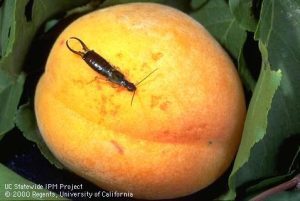What To Do When You Have An Earwig Problem
My garden is being devoured by earwigs this year! Corn seedlings are snipped off at the soil line. Bean seedlings have skeletons in place of leaves. Squash plants, that had been left alone, are now showing small oblong holes in many of the leaves. A lovely black-and-blue sage, Salvia quaranitica, that dies to the ground each winter and had just sent up its first sets of leaves, was completely defoliated overnight.
What to do? A friend suggested “extermination of the beasties.” Being a master gardener, I turned to the statewide Integrated Pest Management Program hosted by the University of California, www.ipm.ucdavis.edu There I found the pest note about earwigs, http://www.ipm.ucdavis.edu/PMG/PESTNOTES/pn74102.html It seems I have created the very problem that I’m now battling – I am my own worst enemy.
Educated as an ecologist, I have adopted the gardening mantra that “nothing leaves the premises.” Neighbors give me bags of leaves every autumn. I pile green clippings – roses, hollyhocks, toyon, oak branches – next to my compost pile and, when the weather is cool enough and I’m in the mood, I haul out my chipper/shredder and turn all of those leaves and dried green prunings into mulch. That mulch gets spread on my veggie garden in the fall and onto walking pathways. Turns out – earwigs LOVE mulch.
Several years ago, I moved into a 45-year-old house that originally had a Bermuda-grass lawn. That same Bermuda grass persistently sneaks into my vegetable garden. This year it got away from me and is growing rampant among the hollyhock stems. So I pull it and use it as mulch-straw around my veggie plants (no, it doesn’t seem to root once it’s dried and dead). However, that’s just another layer of hiding places for earwigs. Add water for the young vegetable plants and I’ve created a perfect habitat for earwigs. Everything they love is there – moisture, hiding places in the mulch and rampant Bermuda, succulent green growing things to eat, and decaying organic matter. I’ve created the Mad Hatter’s Tea Party for them.
If you are having earwig problems this year, you may want to follow the plan of attack recommended by the University of California Integrated Pest Management program:
1. TRAP THEM: Roll up a newspaper and, at night, place it close to the area where you’re observing earwig damage. In the morning shake the paper into a bucket of soapy water or shake it out on a hard surface and step on/squish the little you-know-whats. You can also use a short length of hose or piece of bamboo as an attractive (dark and damp) trap. Another recommended trap is a tuna or cat food can sunk into the soil until the upper lip of the can is level with the soil surface. Add ½’ of cooking oil to the trap and bait with a drop of tuna juice or bacon grease. Empty the traps each morning. There is an excellent, very brief YouTube video describing the process at: https://www.youtube.com/watch?v=42yz-hV0sSI Continue trapping until you no longer catch earwigs.
2. SANITATION: Remove mulch and weeds, ground covers that hold moisture and vines growing up buildings in areas where earwigs are creating a problem. As for me, I’m going to get rid of the border of long Bermuda grass next to my vegetable garden. I don’t know if I can really convince myself to get rid of the mulch – I hope trapping will help reduce the problem.
3. TOLERANCE: Please note: earwigs are also considered a beneficial insect because they voraciously eat aphids, other soft-bodied insects and their eggs. An all-out chemical war against earwigs is neither warranted nor wise. If you’re not having a problem with earwigs this year, congratulations. If you are fighting earwigs, join me in my sanitation and trapping campaign – misery loves company!
Rebecca Miller-Cripps is a University of California Cooperative Extension Master Gardener of Tuolumne County.

